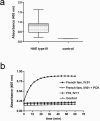Increased activity of coagulation factor XII (Hageman factor) causes hereditary angioedema type III
- PMID: 17186468
- PMCID: PMC1698720
- DOI: 10.1086/509899
Increased activity of coagulation factor XII (Hageman factor) causes hereditary angioedema type III
Abstract
Hereditary angioedema (HAE) is characterized clinically by recurrent acute skin swelling, abdominal pain, and potentially life-threatening laryngeal edema. Three forms of HAE have been described. The classic forms, HAE types I and II, occur as a consequence of mutations in the C1-inhibitor gene. In contrast to HAE types I and II, HAE type III has been observed exclusively in women, where it appears to be correlated with conditions of high estrogen levels--for example, pregnancy or the use of oral contraceptives. A recent report proposed two missense mutations (c.1032C-->A and c.1032C-->G) in F12, the gene encoding human coagulation factor XII (FXII, or Hageman factor) as a possible cause of HAE type III. Here, we report the occurrence of the c.1032C-->A (p.Thr328Lys) mutation in an HAE type III-affected family of French origin. Investigation of the F12 gene in a large German family did not reveal a coding mutation. Haplotype analysis with use of microsatellite markers is compatible with locus heterogeneity in HAE type III. To shed more light on the pathogenic relevance of the HAE type III-associated p.Thr328Lys mutation, we compared FXII activity and plasma levels in patients carrying the mutation with that of healthy control individuals. Our data strongly suggest that p.Thr328Lys is a gain-of-function mutation that markedly increases FXII amidolytic activity but that does not alter FXII plasma levels. We conclude that enhanced FXII enzymatic plasma activity in female mutation carriers leads to enhanced kinin production, which results in angioedema. Transcription of F12 is positively regulated by estrogens, which may explain why only women are affected with HAE type III. The results of our study represent an important step toward an understanding of the molecular processes involved in HAE type III and provide diagnostic and possibly new therapeutic opportunities.
Figures




Similar articles
-
Coagulation Factor XII Gene Mutation in Brazilian Families with Hereditary Angioedema with Normal C1 Inhibitor.Int Arch Allergy Immunol. 2015;166(2):114-20. doi: 10.1159/000376547. Epub 2015 Mar 13. Int Arch Allergy Immunol. 2015. PMID: 25790805
-
Hereditary angioedema with normal C1-INH with versus without specific F12 gene mutations.Allergy. 2015 Aug;70(8):1004-12. doi: 10.1111/all.12648. Epub 2015 May 22. Allergy. 2015. PMID: 25952149
-
Treatment for hereditary angioedema with normal C1-INH and specific mutations in the F12 gene (HAE-FXII).Allergy. 2017 Feb;72(2):320-324. doi: 10.1111/all.13076. Epub 2016 Dec 1. Allergy. 2017. PMID: 27905115
-
Clinical features of genetically characterized types of hereditary angioedema with normal C1 inhibitor: a systematic review of qualitative evidence.Orphanet J Rare Dis. 2020 Oct 15;15(1):289. doi: 10.1186/s13023-020-01570-x. Orphanet J Rare Dis. 2020. PMID: 33059692 Free PMC article.
-
Hereditary angioedema with normal C1 inhibitor activity including hereditary angioedema with coagulation factor XII gene mutations.Immunol Allergy Clin North Am. 2006 Nov;26(4):709-24. doi: 10.1016/j.iac.2006.09.003. Immunol Allergy Clin North Am. 2006. PMID: 17085286 Review.
Cited by
-
[Diagnostics and exclusion of hereditary angioedema : a standarized approach for the practice].Hautarzt. 2012 Jul;63(7):567-72. doi: 10.1007/s00105-012-2388-x. Hautarzt. 2012. PMID: 22751857 Review. German.
-
In vivo roles of factor XII.Blood. 2012 Nov 22;120(22):4296-303. doi: 10.1182/blood-2012-07-292094. Epub 2012 Sep 19. Blood. 2012. PMID: 22993391 Free PMC article. Review.
-
The establishment and utility of Sweha-Reg: a Swedish population-based registry to understand hereditary angioedema.BMC Dermatol. 2007 Nov 30;7:6. doi: 10.1186/1471-5945-7-6. BMC Dermatol. 2007. PMID: 18053127 Free PMC article.
-
Angioedema Without Wheals: Challenges in Laboratorial Diagnosis.Front Immunol. 2021 Dec 8;12:785736. doi: 10.3389/fimmu.2021.785736. eCollection 2021. Front Immunol. 2021. PMID: 34956216 Free PMC article. Review.
-
Brazilian Guidelines for Hereditary Angioedema Management - 2017 Update Part 1: Definition, Classification and Diagnosis.Clinics (Sao Paulo). 2018;73:e310. doi: 10.6061/clinics/2018/e310. Epub 2018 May 3. Clinics (Sao Paulo). 2018. PMID: 29723342 Free PMC article.
References
Web Resources
-
- DMLE+ Disease Mapping Using Linkage Disequilibrium, http://dmle.org/
-
- Online Mendelian Inheritance in Man (OMIM), http://www.ncbi.nlm.nih.gov/Omim/ (for HAE and HAE type III)
References
-
- Agostoni A, Aygoren-Pursun E, Binkley KE, Blanch A, Bork K, Bouillet L, Bucher C, et al (2004) Hereditary and acquired angioedema: problems and progress: proceedings of the third C1 esterase inhibitor deficiency workshop and beyond. J Allergy Clin Immunol 114:S51–S13110.1016/j.jaci.2004.06.047 - DOI - PMC - PubMed
-
- Tosi M (1998) Molecular genetics of C1 inhibitor. Immunobiology 199:358–365 - PubMed
Publication types
MeSH terms
Substances
LinkOut - more resources
Full Text Sources
Other Literature Sources
Medical
Molecular Biology Databases
Miscellaneous

